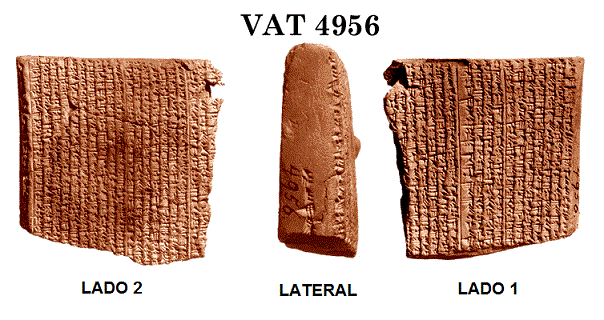
BRIEF
ANALYSIS OF SERIES "WHEN WAS ANCIENT JERUSALEM DESTROYED?"
(series
published in Watchtower, 10/01/2011
and 11/01/2011)
CONTENT
Introduction
1. Overview of the Two Articles and the Main Scholar Consulted
Consideration upon Part 1
2. The Seventy Years of Babylon
3. The Base that Exists for the Year 587 BC
4. The Desolation of Jerusalem and the Seventy Years
Consideration upon Part 2
5. Commenting on the Archaeological Evidence
6. Astronomical Simulations of the VAT 4956
Conclusão Conclusion
7. The Real Reason Why They Do Not Leave the Year 607 BC
A. Bibles Printed by the Watchtower that Translate Correctly Jeremiah 29:10
B. The Year 609 BC was the Beginning of the Seventy Years of Babylon According to Historians
C. Notions of Archaeoastronomy, Calendars and Language of Astronomical Diaries
D. Answers from Scholars Quoted in the Series "When Was Ancient Jerusalem Destroyed?" (PDF, 1.09 Mb)
E. Response to a Reader - Refers to the Series "When Was Ancient Jerusalem Destroyed?"
References
Images Credits Used
Unless otherwise indicated, the translation of the Bible used in this work is the "New World Translation."
Introduction
1. Overview of the Two Articles and the Main Scholar Consulted
Waiting...
Consideration upon Part 1
2. The Seventy Years of Babylon
Waiting...
3. The Base that Exists for the Year 587 BC
Waiting...
4. The Desolation of Jerusalem and the Seventy Years
Waiting...
Consideration upon Part 2
5. Commenting on the Archaeological Evidence
Waiting...
6. Astronomical Simulations of the VAT 4956
It was mentioned in the previous consideration that almost none of the 13 positions fits the lunar year 588 BC. On the other hand, almost all fit perfectly to the year 568 BC. What makes the date 587 BC the year that Jerusalem was destroyed. To prove this, all 13 positions of the moon recorded in VAT 4956 will be shown here, using the astronomy program "Starry Night". But it's good to say that the software mentioned in the "Watchtower" magazine also lead to similar results, as attested staff from Berean Minds site.
If you are not familiar with astronomy programs and does not know the way that the ancient Babylonian scribes wrote the astronomical events, it is recommended that you read Appendix C, entitled "Notions of Archaeoastronomy, Calendars and Language of Astronomical Diaries" in end of this commentary.
Attention! The descriptions of the diary that you see at the 13 simulations below are a free translation to facilitate understanding (read the note at the end of this page). If you want to see the text of the tablet as it is in the original, click the image below.
To view all the 13 positions mentioned in lunar astronomical diary VAT 4956 see the simulations below.
The coordinates chosen to do the simulations were the place where the ancient Babylon stood:
Latitude: 32º 33' N
Longitude: 44º 25' E
In the "Time Zone" you must enter the number 3.
The criteria used to indicate if a simulation fits or not were:
1) For the distance between the Moon and a constellation: errors until 2 degrees were ignored.
2) For the distance between the moon and a star of a specific constellation: errors until 1 degree were ignored.
3) For other situations were discarded any errors, since the overall picture is consistent with the tablet.
These small differences do not affect the quality of the simulations, as they are within an acceptable margin of error of the software in relation to what was actually observed, not to mention that the measurement systems in Antiquity were not as accurate as those of today.
Lunar Observation Nº 01
Waiting...
Lunar Observation Nº 02
Waiting...
Lunar Observation Nº 03
Waiting...
Lunar Observation Nº 04
Waiting...
Lunar Observation Nº 05
Waiting...
Lunar Observation Nº 06
Waiting...
Lunar Observation Nº 07
Waiting...
Lunar Observation Nº 08
Waiting...
Lunar Observation Nº 09
Waiting...
Lunar Observation Nº 10
Waiting...
Lunar Observation Nº 11
Waiting...
Lunar Observation Nº 12
“Night of the 7th, the moon was surrounded by a halo. Cancer and a Leonis stood in it.”
Day of the event according to the experts: March 20-21, 567 BC
Adjusting the program to this dateis obtained the following:
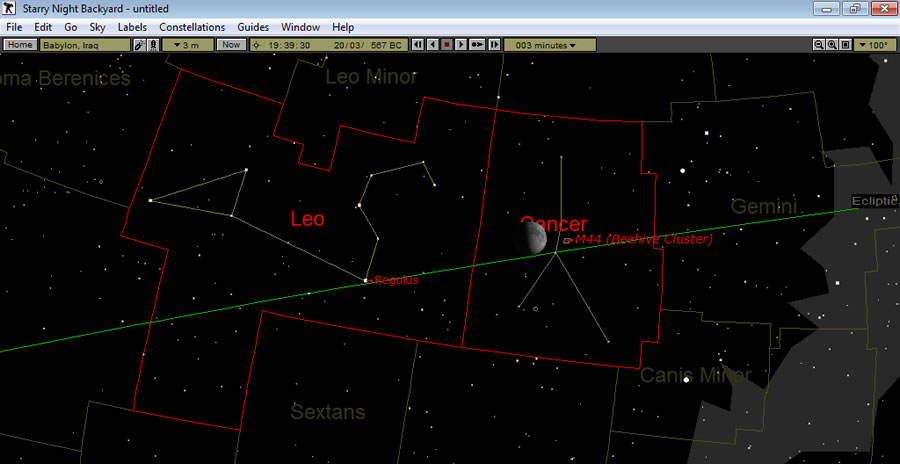
It is observed that the Moon is between Cancer and Regulus (alpha Leo), as reported in the diary.
Day of the event according to the Watchtower: 29-30 March 587 BC
Adjusting the program to this dateis obtained the following:
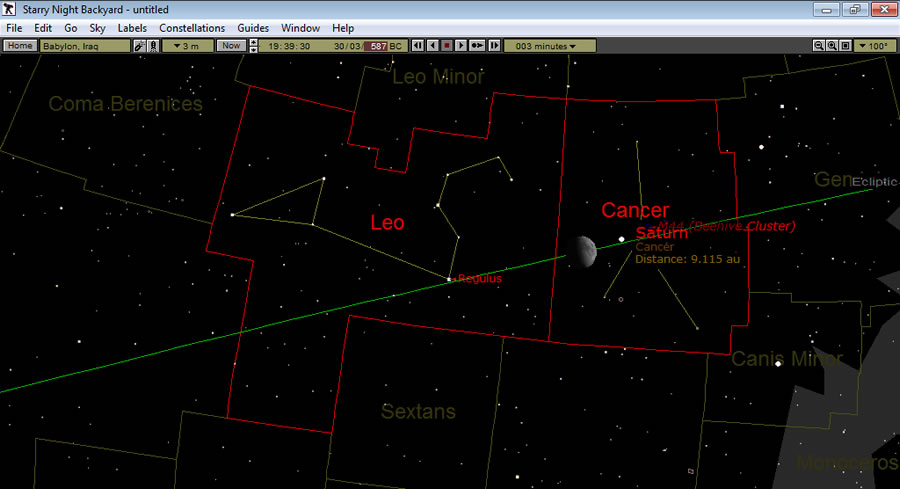
Observa-se que a Lua também está entre Câncer e Regulus (a alfa de Leão), conforme informado no diário. O único detalhe diferente neste cenário é que o planeta Saturno aparece em conjunção com a Lua. O que talvez tivesse chamado atenção do escriba, caso este fosse o céu com o qual se deparou naquela noite do dia 7 de adaru, do 37º ano de Nabucodonosor...
It is observed that the Moon is also among Cancer and Regulus (alpha Leo), as reported in the diary. The only thing different in this scenario is that the planet Saturn appears in conjunction with the moon, what might have drawn attention of the scribe, if that was the sky with which he met that night of the 7th of adaru, in the 37th year of Nebuchadnezzar ...
Conclusion:
The date of specialists fits the story of the diary? Yes.
The date of Watchtower fits the story of the diary? Yes.
"The moon was surrounded by a halo. Cancer and a Leonis stood in it"
Indeed, the astronomical diary reports that the Moon was among the "Praesepe" and Alpha Leo (who is the star Regulus). "Praesepe" or "Beehive" is an open cluster located in the constellation Cancer and has been known since ancient times. Currently, is identified in Messier catalog by M44. On this cluster, some website states the following:
"The open clusters are objects that form the backbone of our galaxy. So when we are observing an open cluster, we are observing a region of the galactic plane, but specifically in the spiral arms. The stars that form these objects are young stars and very hot, in general, so it is not rare to observe cloudiness around clusters of these types, they may be associated with immersed regions at ionized material due to high temperatures such as the Nebula Eagle M16. "- Astronomical Observatory of the Federal University of Espirito Santo, Brazil.
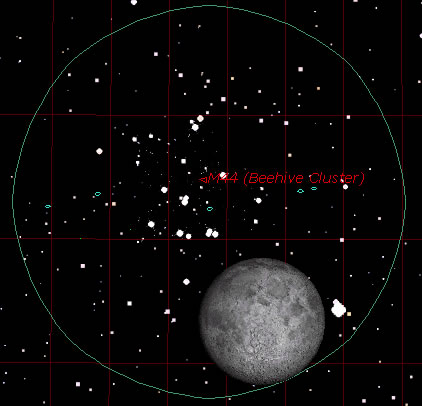
Open cluster Praesepe (M44)
Praesepe is in the constellation Cancer and is not part of the constellation Leo. So it could not cause an effect that would encompass these two constellations. Although the characteristic cloudiness of the Beehive cluster may have caused some effect on the sighting of the moon, the more likely it is that the scribe description was referring to the refractive halo may form around the moon, on which the Barsa Encyclopedia says:
"Atmospheric phenomenon characterized by the appearance of one or more light rings around the Sun or the Moon. Triggered by the refraction of light from the object through the ice crystals in clouds of high zone of the atmosphere."
Since such halos can reach over 40 degrees, then it is perfectly possible that the halo has covered the constellations Leo and Cancer. In fact, in the next line on the tablet the scribe tells that "the halo circled Cancer and Leo," as illustrated in the following photo:
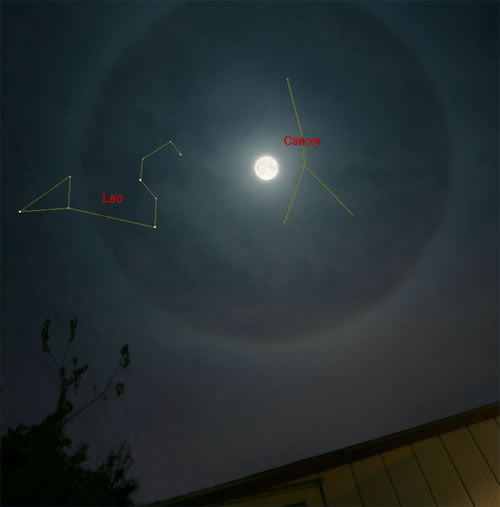
Lunar Observation Nº 13
Waiting...
(end of simulations)
As observed in the Starry Night, the simulations presented above is summarized at the following table:
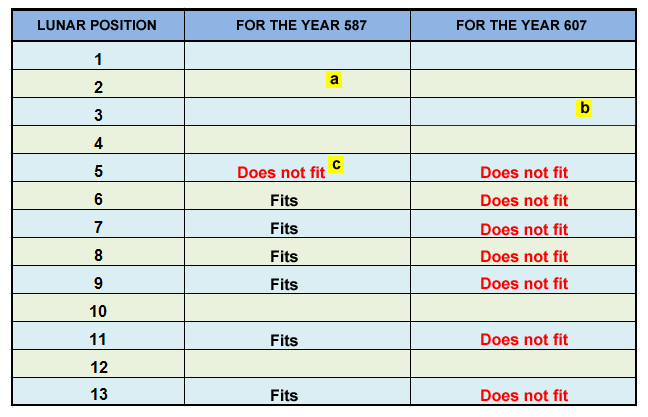
Table notes:
a - xxxx.*
b - xxxx.
c - It is said on the tablet that the moon was near the star Beta Virgo, but it was close to gama. If the scribe was wrong and should be the star gama, then the observation fits.

"8" e "9" in cuneiform writing
To facilitate understanding of the text of the VAT 4956, the following conventions have been adopted in the text presented here:
1 cubit = 2 degrees
2 cubit = 4 degrees
2,5 cubit = 5 degrees
3,5 cubit = 7 degrees
Lion's Foot = beta Virgin
Swallow = constellation of Pisces
Praesepe = constellation Cancer (actually, is an open cluster that is in this constellation)
The words to the left (in bold) are the terms that were used by the Babylonian scribes. What appears on the right side are the appropriate meanings of these terms. In the translation used in the simulations, was chosen the meaning of the terms used in the tablet, instead of ancient vocabulary. So, remember that the language used in the original diary is another. If you want to see the original text with the old manner, click on the image of the tablet that is on top of this page.
Were made also the following equivalences:
1,3 degrees = 6 minutes
20 degrees = 80 minutes
25 degrees = 100 minutes
Keep reading about this matter in the link below:
Brief analysis of Series "When Was Ancient Jerusalem Destroyed?" - Conclusion
Conclusion
7. The Real Reason Why They Do Not Leave the Year 607 BC
Waiting...
Appendix:
A. Bibles Printed by the Watchtower that Translate Correctly Jeremiah 29:10
Waiting...
B. The Year 609 BC was the Beginning of the Seventy Years of Babylon According to Historians
Waiting...
C. Notions of Archaeoastronomy, Calendars and Language of Astronomical Diaries
Waiting...
D. Answers from Scholars Quoted in the Series "When Was Ancient Jerusalem Destroyed?" (PDF, 1.09 Mb)
I wrote to some scholars* cited in the series "When was ancient Jerusalem destroyed?", asking what they think of the conclusions published in the "Watchtower" (10/1/2011 and 11/1/2011), and the way they have been cited to discredit the year 587 BC. Although there is a note in the magazine stating that "none of the secular experts quoted in this article hold that Jerusalem was destroyed in 607 B.C.E.," it is interesting to know what they think because Watchtower's writer tries to find in these experts some information that may weaken the date 587. In a role reversal, it is as if scholars were ignoring information in favor of a preconceived misconception.
Since these scholars may be being inundated with emails because of these recent articles published by the "Watchtower", maybe not all of them feel comfortable to answer. But those who give some feedback I will publish their answers here.
To see an answer, click on the desired link below. To return to the top of this page, simply click the name of the scholar.
8. Annette Imhausen
10. S. M. Burstein
11. Leo Depuydt
12. Christopher Walker
13. G. J. Toomer
* I point out that some important scholars mentioned in the Watchtower magazine can not be asked about the issues because they have died. This is the case of Raymond P. Dougherty and J. Abraham Sachsª. Fortunately, the latter was interviewed on June 24, 1968 at Brown University, Rhode Island, by Raymond Franz, who had been charged by the Watchtower to write the article "chronology" of the Bible encyclopedia "Aid to Bible Understanding", in English (Franz later became a member of the "Governing Body" of the "Jehovah's Witnesses"). The purpose of this interview was to know from Dr. Sachs if had any evidence that would favor the date 607 BC for the destruction of Jerusalem. Raymond Franz tells in his book "Crisis of Conscience" that Sachs made it clear that there is no such possibility. - Crisis of Conscience, 4th edition, in English, p. 30 and private communication maintained with the author.
ª Dougherty is mentioned in footnote 10 and Sachs on pages 26 and 27, and some notes. - The Watchtower, 11/1/2011.
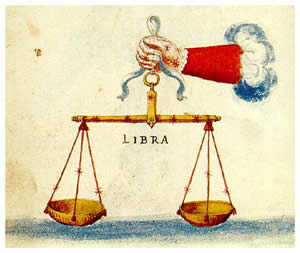
On October 12, 2011 I wrote the following email to Dr. Sack:
Hi Dr. Sack,
The
Watchtower magazine of November, 2011 published an article on Neo-Babylonian
chronology. The magazine mentions that the sources that support the date 587
BC for destruction of Jerusalem are not reliable. To support this point of view,
they quote you several times, among other experts. See an example below:
“What have experts said? R. H. Sack, a leading authority on cuneiform
documents, states that the chronicles provide an incomplete record of important
events. He wrote that historians must probe ‘secondary sources . . . in
the hope of determining what actually happened.’
“What do the documents show? There are gaps in the history recorded in
the Babylonian chronicles.3 (See the box below.) Logically, then, the question
arises, how reliable are deductions”.
So I ask, do you agree somehow with Watchtower on this application? Is there
really any chance of the year 587 BC be wrong?
I am a Brazilian researcher who writes about ancient Biblical history and I
would appreciate your response.
Thank you,
Adelmo Medeiros
On October 13, 2011 Dr. Sack sent me the answer below:
I have already responded to many who have asked this question. The Watchtower misrepresents me entirely. The date for the destruction of Jerusalem is 587 BC The article in the Watchtower is unsigned and a complete misrepresentation of my work. Marjorie alley of the Archaeological Institute of America has correctly represented me on her webpage where she correctly quotes my book Neriglissar---King of Babylon pp 25-26.
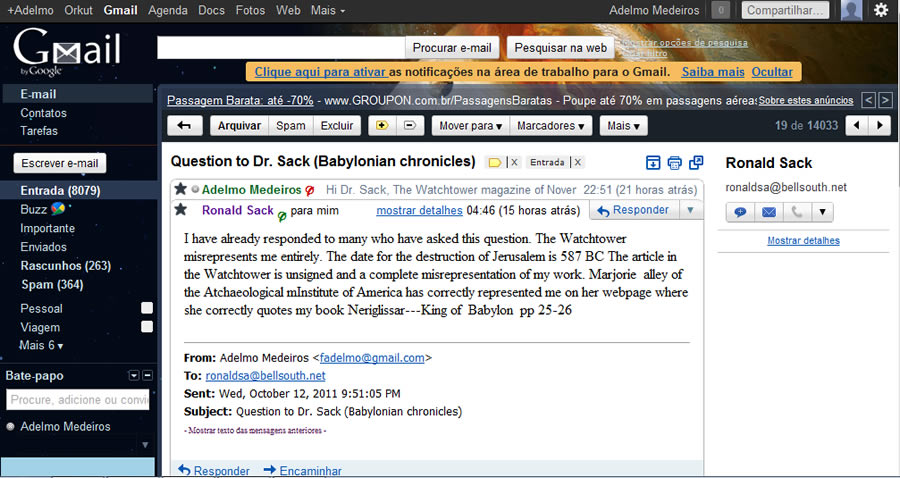
On October 12, 2011 I wrote the following email to Dr. Steele:
Dear Dr. Steele,
The
Watchtower magazine of November, 2011 (published by Jehovah's Witnesses)
quoted you several times in an article on Neo-Babylonian chronology. The author
mentions the tablet VAT
4956, and says that its astronomical information could have been made by
calculating backwards. In other words, such observations were calculated and
not observed. To support this point of view you was quoted in Article, on page
24:
“But could the Babylonians project backward to calculate when eclipses
had occurred in the past? ‘It is possible,’ states Professor John
Steele, ‘that some of the earliest predictions could have been made by
projecting the scheme backwards when the text was compiled’. (Italics
ours.)”
So I ask, the above statement actually apply to the VAT 4956?
I am a Brazilian researcher who writes about ancient Biblical history and I would appreciate your response.
Thank you,
Adelmo Medeiros
Dr. Steele removed his email on site of the University of Durham. This seems to indicate that he no longer wants to answer emails on the subject published in the "Watchtower". Fortunately, Dr. Steele had already responded to an email with a similar content that was sent by Marjorie Alley, which is from the Archaeological Institute of America, as reported for Dr. Sack.
On September 2, 2011, Alley received the following response from John Steele:
Dear Ms Alley,
Thank you for your email concerning the citation of my work in the recent Watchtower article. As you suggest the author of this piece is completely misrepresenting what I wrote, both in what they say about the lunar three measurements, and in what I say about the possibility of retrocalculation of eclipses (my comments on the latter were restricted to a distinct and small group of texts which are different to the Diary they are discussing). Just glancing through the Watchtower article I can see that they have also misrepresented the views of other scholars by selective quotation out of context.
I've looked at the date of VAT 4956 on several occasions and see no possibility that it can be dated to anything other than the conventional date.
Regards,
John Steele
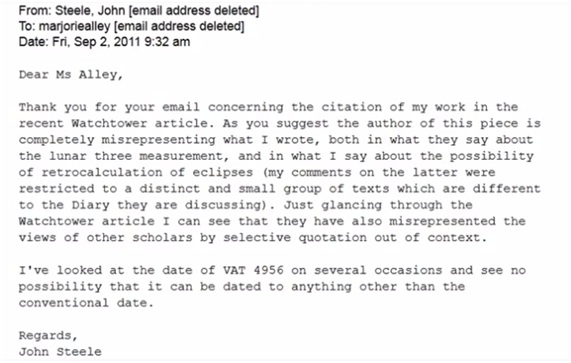
Available
at Jehovahs-Witness.net
On October 13, 2011, I wrote the following email to Dr. Brown:
Hi Dr. Brown,
The Watchtower magazine of November 1, 2011 published an article on Neo-Babylonian chronology. The magazine mentions that the sources that support the date 587 BC for destruction of Jerusalem are not reliable. To support this point of view, they mention your work, among other. See below:
“Professor David Brown, who believes that the astronomical charts included predictions made shortly before the recorded events, acknowledges that it is conceivable that some of these were ‘retrocalculations undertaken by scribes in the 4th and later centuries BC.’ If these are retrocalculations, could they really be considered absolutely reliable unless corroborated other evidence?”
Watchtower says that VAT 4956 is not reliable for the reasons above. In other words, the observations were calculated and not observed.
So I ask, do you agree somehow with Watchtower on this application of your work? Is there really any chance of the year 587 BC be wrong? The year 607 would be correct, for destruction of Jerusalem?
I am a Brazilian researcher who writes about ancient history and I would appreciate your response.
Thank you,
Adelmo Medeiros
On October 13, 2011, Dr. Brown answered:
I think, I replied already, that I have left the field and do not concern myself with such questions anymore. I wish you luck with your work, but would ask you to respect my privacy.
Dr. David Brown
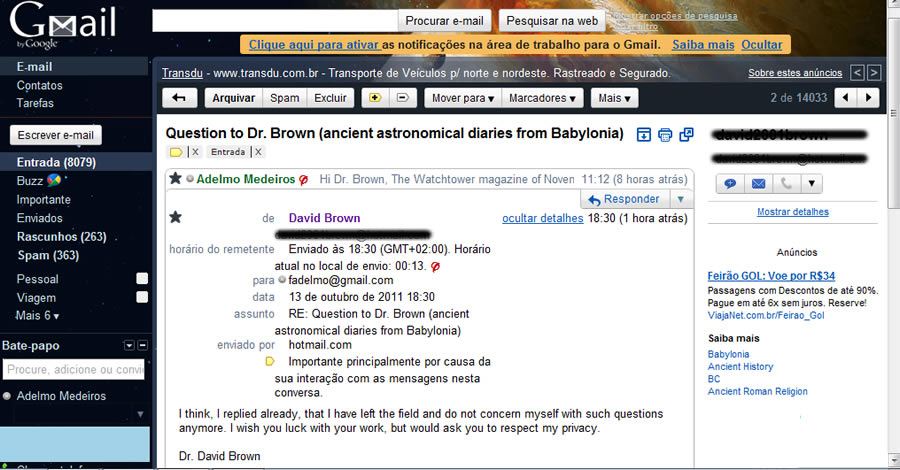
Due to the above e-mail content, I post my answer here, sent on October 13, 2011:
Thanks for replying, Dr. Brown. Sorry to bother you with this matter. I did not know you did not work more in the field. I'll try to find the answer you gave about what I asked. But I confess that I do not really know where it is published.
Thank you,
Adelmo Medeiros
On October 13, 2011, I wrote the following email to Dr. Bert van der Spek:
Hi Dr. van de Spek,
The Watchtower magazine of November 1, 2011 published an article on Neo-Babylonian chronology. The magazine mentions that the sources that support the date 587 BC for destruction of Jerusalem are not reliable. To support this point of view, they mention your work. See below:
“Even if an eclipse did occur on a certain date, does this mean that the historical information the writer of the tablet assigns to that date is accurate? Not necessarily. Scholar R. J. van der Spek explains: ‘The compilers were astrologers, not historians.’ He describes sections of the tablets that contain historical records as ‘more or less casual,’ and he warns that such historical information must ‘be used with caution.’”
Watchtower says that VAT 4956 is not reliable for the reason above, among other.
So I ask, do you agree somehow with Watchtower on this application of your work? Is there really any chance of the year 587 BC be wrong? The year 607 would be correct, for destruction of Jerusalem?
I am a Brazilian researcher who writes about ancient history and I would appreciate your response.
Thank you,
Adelmo Medeiros
On October 24, 2011, Dr. Bert answered:
Dear mr. Medeiros,
Thanks for your e-mail. Someone from the Netherlands also contacted me about this question.
The quotes from my article are correct, but quoted out of context. What I have argued is actually exactly the opposite. The Babylonian scholars were good scientists and made accurate records of the celestial phenomena, which can be checked by modern astronomers. The historical information of the astronomical diaries can very often also be checked with the help of other sources and they are usually correct. This I showed in the rest of my article, which you can find here:
The Astronomical Diaries as a source for Achaemenid and Seleucid History
The same is true for the historical information of the chroniclers, who were the same people, as I have argued in the Festschrift Stol Reference to the book (though not to the article) you can find here:
So I dare to say that the information of Chronicle ABC 5 rev. 12, that Jerusalem was taken for the first time on 2 Adar 7th year of Nebuchadnezzar = 16 March 597 BC (in the Julian Calendar). The second deportation is dated to 587 and 586 BC. From this we do not have Babylonian evidence, but the biblical information is ambiguous.
Of course the historical information of the diaries should be used with caution, as should be done with all historical information. The interest of the scholars was in collecting information from the sky with information on earth, and they had special interest in the fate of the king and events in Babylon. And they did this with a surprising accuracy. Events from far away they heard from “hearsay”, and these events cannot be dated with the same accuracy as the events in Babylon. But it is flatly impossible to backdate events twenty years. As happens so often in this kind of argumentation: the authors find a few texts with some minor problems, try to solve it be a substantial change in the accepted chronology, and so creating thousands of new problems, which they do not (and cannot) solve. The documentary basis for the traditional chronology is so overwhelming that it in fact a waste of time to discuss it in great detail.
All my best,
Prof. dr. R.J. (Bert) van der Spek
Professor of Ancient History
Vrije Universiteit / VU University Amsterdam
Faculteit der Letteren / Faculty of Arts
Afdeling Oudheid / Dept. of Archaeology, Classics and Ancient Near Eastern Studies
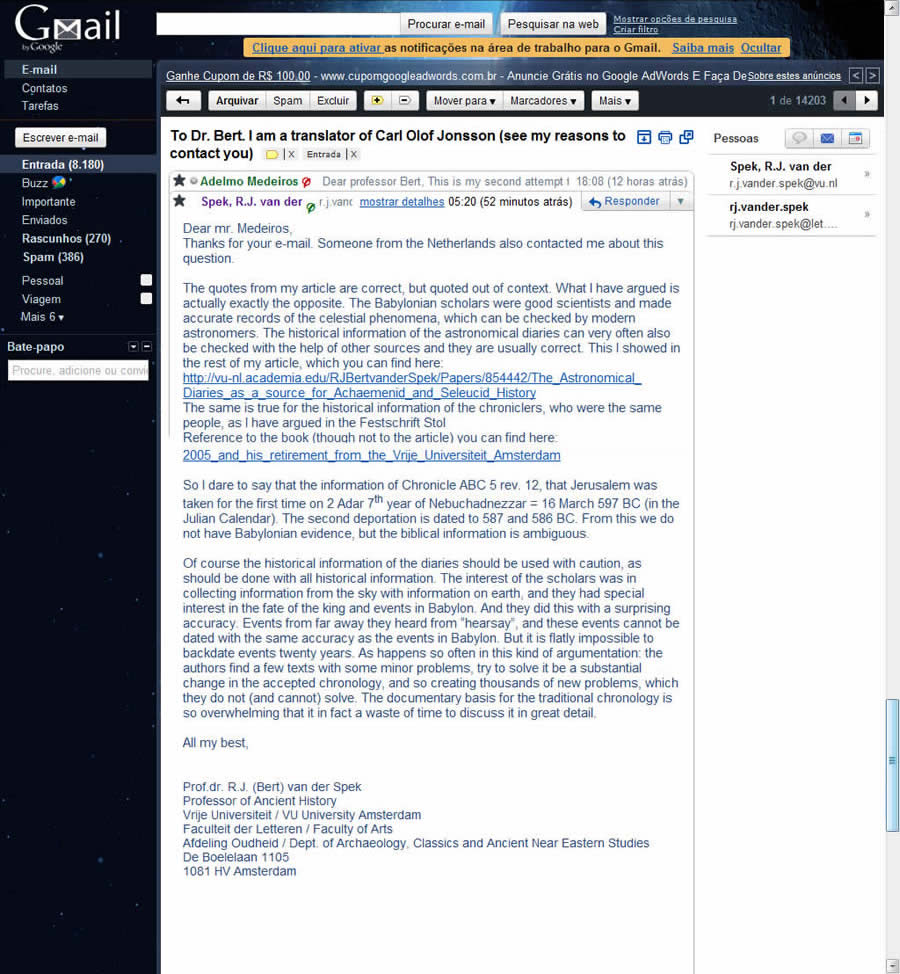
On October 14, 2011, I wrote the following email to Dr. Huber:
Dear
Dr.
Huber,
The Watchtower magazine of November 1, 2011 published an article on
Neo-Babylonian chronology, where it mentions that the sources that support the
date 587 BC for the destruction of Jerusalem are not reliable.
The magazine also reports that the tablet VAT 4956 has evidence that the Neo-Babylonian
period was 20 years longer than we think. To support this point of view your
book Babylonian Eclipse Observations From 750 BC to 1 BC is quoted on p. 28
(see attached images).
Your work does really provide a clue to reach the above conclusion?
I am a Brazilian researcher who writes about ancient history and would appreciate
receiving your response.
Thank you,
Adelmo Medeiros
On October 15, 2011, Dr. Huber answered:
Dear Dr. Medeiros,
I do not think that our book provides evidence for an earlier date of VAT 4956 from the 37th year of Nekukadnezar, quite on the contrary! Both eclipses of July 4, 568 BC and July 15, 588 BC were invisible in Babylon (below the horizon), and the earlier eclipse actually is mentioned in a text as occurring in month IV, see Huber - De Meis, p.89.
The last complete treatment of VAT 4956 is in:
A. J. Sachs and H. Hunger, Astronomical Diaries and Related Texts from Babylonia, Vol. I, (1988), Vienna, p.46-53.
I always had thought that the date of the text was uniquely fixed by copious planetary and lunar observations. As far as I remember, this had been checked by P.V.Neugebauer and E.F.Weidner already in 1915. I never had felt it necessary to check myself.
Yours,
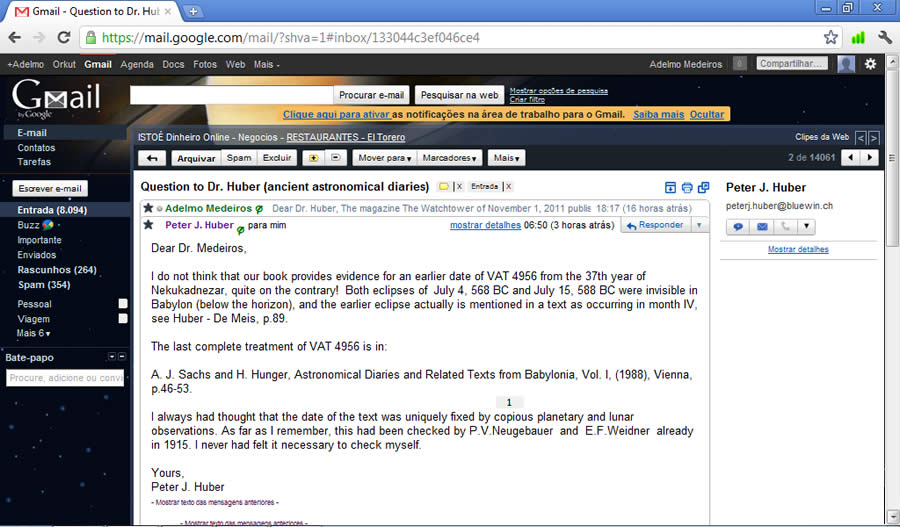
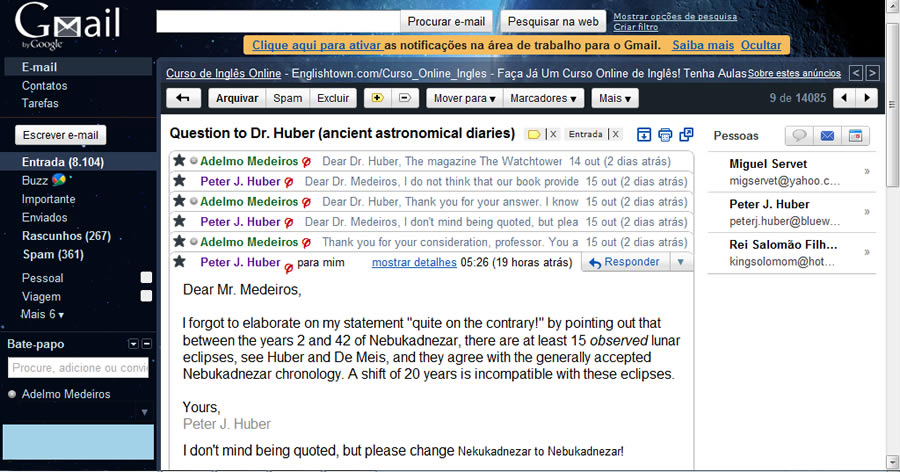
On October 14, 2011, I wrote the following email to Dr. Stephenson:
Hi,
Dr. Stephenson
I am a Brazilian researcher who writes about ancient history, and would like
to know your opinion about a subject. I would greatly appreciate your response.
The Watchtower magazine of November 1, 2011 published an article on
Neo-Babylonian chronology, where it mentions that the sources that support the
date 587 BC for the destruction of Jerusalem are not reliable. In addition,
the magazine also reports that the astronomical diary VAT 4956 has evidence
that the Neo-Babylonian period was 20 years longer than we think.
By introducing the above subject, your article "The Earliest Datable Observation
of the Aurora Borealis" is mentioned (as you know, it was published in
Under One Sky - Astronomy and Mathematics in the Ancient Near East).
So, I ask, since you are an expert in archaeoastronomy, is there some possibility
of these ancient astronomical diaries support this matter published in this
magazine?
Regards,
Adelmo Medeiros
See the answer below from Dr. Willis, who also responded on behalf of Dr. Stephenson.
On October 14, 2011, I wrote the following email to Dr. Willis:
Hi,
Dr.
Willis
I am a Brazilian researcher who writes about ancient history, and would like
to know your opinion about a subject. I would greatly appreciate your response.
The Watchtower magazine of November 1, 2011 published an article on Neo-Babylonian
chronology, where it mentions that the sources that support the date 587 BC
for the destruction of Jerusalem are not reliable. In addition, the magazine
also reports that the astronomical diary VAT 4956 has evidence that the Neo-Babylonian
period was 20 years longer than we think.
By introducing the above subject, your article "The Earliest Datable Observation
of the Aurora Borealis" is mentioned (as you know, it was published in
Under One Sky - Astronomy and Mathematics in the Ancient Near East).
So, I ask, since you are an expert in archaeoastronomy, is there some possibility
of these ancient astronomical diaries support this matter published in this
magazine?
Regards,
Adelmo Medeiros
On 10/18/2011 Dr. Willis replied:
.................................................... one part was omitted temporarily at the request by the sender .............................................................
Dear Adelmo Medeiros,
Thank you for your inquiry about the article in the magazine The Watchtower (November 1, 2011). Other researchers have also drawn this article to the attention of Professor Richard Stephenson and myself.
Professor Richard Stephenson and I believe that the date given in our article entitled “The Earliest Datable Observation of the Aurora Borealis” is correct.
- - - - - - - - - - - - - - - - - - - - - - - - - - - - - - - - - - - - - - - - - - - - - - - - - - - - - - - - - - - - - - - - - - - - - - - - - - - - - - - - - - - - - - - - - - - - - - - - - - - - - - - - - - - - - - - - - - - - - - - - - - - - - - - - - - - - - - - - - - - - - - - - - - - - - - - - - - - - - - - - - - - - - - - - - - - - - - - - - - - - - - - - - - - - - - - - - - - - - - - - - - - - - - - - - - - - - - - - - - - - - - - - - - - - - - - - - - - - - - - - - - - - - - - - - - - - - - - - - - - - - - - - - - - - - - - - - - - - - - - - - - - - - - - - - - - - - - - - - - - - - - - - - - - - - - - -.
- - - - - - - - - - - - - - - - - - - - - - - - - - - - - - - - - - - - - - - - - - - - - - - - - - - - - - - - - - - - - - - - - - - - - - - - - - - - - - - - - - - - - - - - - - - - - - - - -.
Best regards,
David Willis
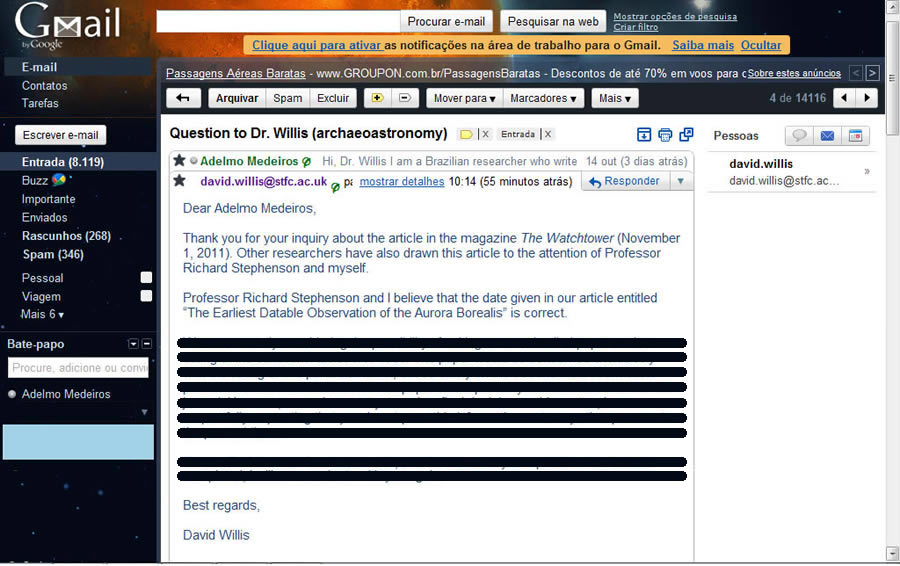
On October 14, 2011, I wrote the following email to Dr. Imhausen:
Dear
Dr. Imhausen,
I am a Brazilian researcher who writes about ancient history, and would like
to know your opinion about a subject. I would greatly appreciate your response.
The Watchtower magazine of November 1, 2011 published an article on
Neo-Babylonian chronology, where it mentions that the sources that support the
date 587 BC for the destruction of Jerusalem are not reliable. In addition,
the magazine also reports that the astronomical diary VAT 4956 has evidence
that the Neo-Babylonian period was 20 years longer than we think.
When introducing the subject above, they cite the article “The Earliest
Datable Observation of the Aurora Borealis” which was published in the
work Astronomy and Mathematics in the Ancient Near East.
So, since you were editor of the book above (see attached image), I ask:
In your opinion, is there some possibility of these ancient astronomical diaries
support this matter published in this magazine?
Regards,
Adelmo Medeiros
I got no answer from Dr. Imhausen.
On October 16, 2011, I wrote the following email to Dr. De Meis:
Dear
Dr. De Meis,
The Watchtower magazine of November 1, 2011 published an article on
Neo-Babylonian chronology, where it mentions that the sources that support the
date 587 BC for the destruction of Jerusalem are not reliable.
The magazine also reports that the tablet VAT 4956 has evidence that the Neo-Babylonian
period was 20 years longer than we think. To support this point of view your
book Babylonian Eclipse Observations From 750 BC to 1 BC is quoted on p. 28
(see attached images, I forgot to attach the files in another email).
So,
I ask: Do you think your work does really provide a clue to reach the above
conclusion?
I am a Brazilian researcher who writes about ancient history and would appreciate
receiving your response.
Thank you,
Adelmo Medeiros
On October 18, 2011, Dr. De Meis answered:
Dear Dr. Medeiros,
Many thanks for your request.
In “Babylonian Eclipse Observations”, Huber and I do not support the 20 years shift in the chronology.
Prof. Hunger did explain that in the transliteration of VAT 4956 is not mentioned “the moon”, and he is extremely reliable.
It was just a slip in the translation, which is possible for the hundreds of tablets that he published, not a forgery.
Therefore, I suggest that you drop the 20 years shift.
Cordially,
Salvo De Meis
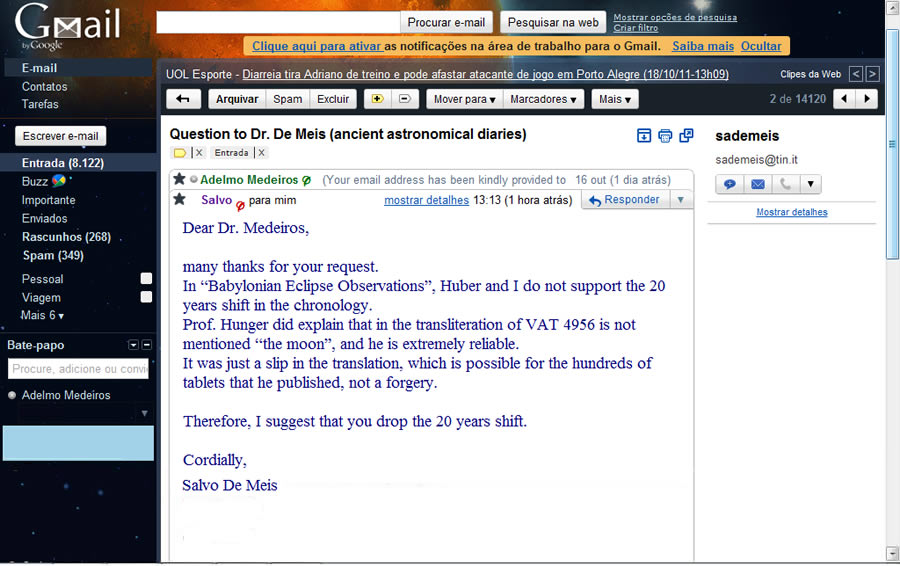
On October 16, 2011, I wrote the following email to Dr. Burstein:
Dear Dr. Burstein,
The Watchtower magazine of October 1, 2011 published an article on Neo-Babylonian chronology, where it mentions that the sources that support the date 587 BC for the destruction of Jerusalem are not reliable. To support this point of view your book is quoted on p. 29:
“How do other scholars view Berosus? ‘In the past Berosus has usually been viewed as a historian,’ states S. M. Burstein, who made a thorough study of Berosus’ works. Yet, he concluded: ‘Considered as such his performance must be pronounced inadequate. Even in its present fragmentary state the Babyloniaca contains a number of surprising errors of simple fact… In a historian such flaws would be damming, but then Berossus’ purpose was not historical.’”
So, I ask: Your book really provides information that leads to conclusion that the year 587 is not supported by reliable sources, being that the book of Berosus is one of them?
I am a Brazilian researcher who writes about ancient history and would appreciate receiving your response.
Thank you,
Adelmo Medeiros
On October 16, 2011, Dr. Burstein answered:
Dear Mr. Medeiros:
Thank you for your email. Unfortunately, the article in the Watchtower is misleading on this point While Berossos clearly did make mistakes as I noted in my book, his account of the capture of Jerusalem, if he discussed it, does not survive. In other words, we have no evidence as to what date he may have assigned to that event and his work in its present fragmentary state is not relevant to its dating.
Sincerely yours, Stanley Burstein
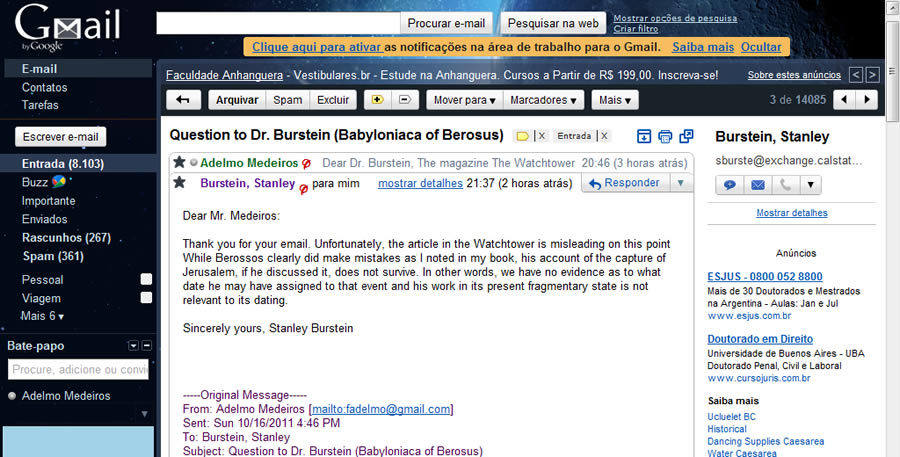
11. LEO DEPUYDT
On October 16, 2011, I wrote the following email to Dr. Depuydt:
Dear Dr. Depuydt,
The Watchtower magazine of October 1, 2011 published an article on Neo-Babylonian chronology, where it mentions that the sources that support the date 587 BC for the destruction of Jerusalem are not reliable. To support this point of view your book is quoted on p. 30:
“ ‘It has long been known that the Canon is astronomically reliable,’ writes Leo Depuydt, one of Ptolemy’s most enthusiastic defenders, ‘but this does not automatically dependable.’ ”
So, I ask: Your book really provides information that leads us to conclusion that the year 587 is not supported by reliable sources, being that the Canon of Ptolemy is just one of them?
I am a Brazilian researcher who writes about ancient history and would appreciate receiving your response, even if your answer is only a few words.
Thank you,
Adelmo Medeiros
On October 16, 2011, Dr. Depuydt answered:
Dear Mr. Medeiros,
Instead of answering directly, I am forwarding my recent correspondence with someone who had a similar question. 607 BCE is out of the question as the date of the destruction of Jerusalem and the evidence is solid.
Thanks and best wishes.
Leo Depuydt
- - -
(Korpela is a reader from Filand).
Dear Mr. Korpela,
The Canon is fully confirmed by many other sources such as Babylonian astronomial Diaries. 607BCE is out of the question as a date of the destruction of Jerusalem. In my article, I was advocating for a more explicit comparison of the Canon with cuneiform texts. I state further down in the article in question that "Agreement seems to be the rule" when it comes to comparing the Canon with the cuneiform record. This statement is based in part on the work of Abraham Sachs and Hermann Hunger on the astronomical diaries. There are numerous overlaps between the Canon and these diaries. There is no doubt that the evidence could be presented more explicitly and in ways that are more accessible to laymen. One problem is that many texts have been published only beginning around twenty years ago. But meanwhile, since my article appeared, there has been more explicit attention to the matter (see for example all the materials posted by Carl Olof Jonsson on http://kristenfrihet.se).
Best wishes.
Leo Depuydt
PS I do not have a scanner.
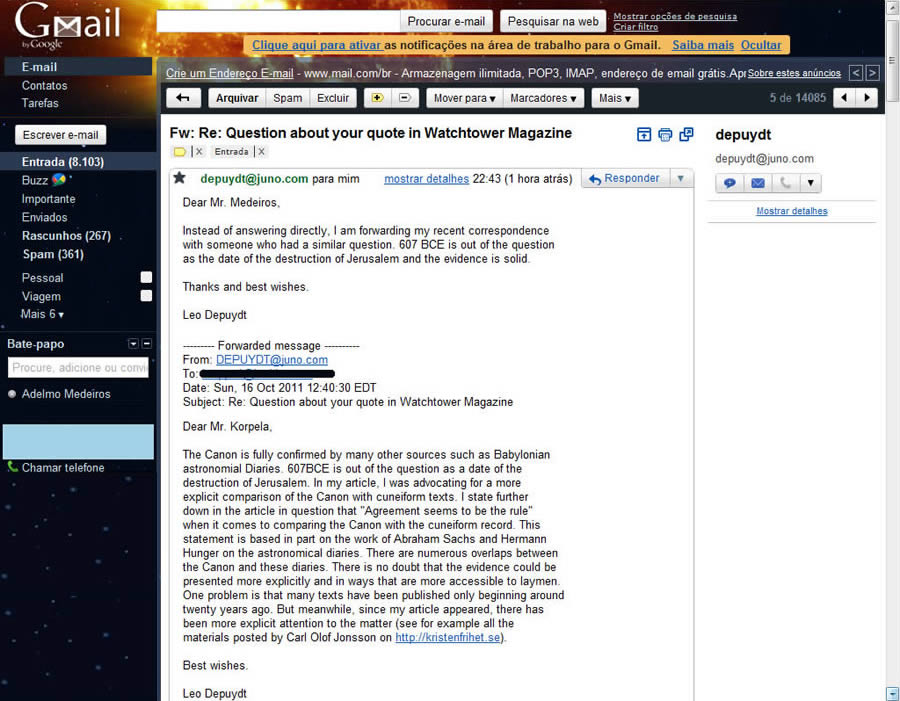
(Korpela is a reader from Filand)
On October 16, 2011, I wrote the following email to Dr. Walker:
Dear Dr. Walker,
The Watchtower magazine of October 1, 2011 published an article on Neo-Babylonian chronology, where it mentions that the sources that support the date 587 BC for the destruction of Jerusalem are not reliable. To support this point of view your book Mesopotamian and Iran in the Persian is quoted on p. 30:
“Thus, Christopher Walker of the British Museum says that Ptolemy’s canon was ‘an artificial scheme designed to provide astronomers with a consistent chronology’ and was ‘not to provide historians with a precise record of the accession and death of kings.’”
So, I ask: Your book really provides information that leads us to conclusion that the year 587 is not supported by reliable sources, being that the Canon of Ptolemy is one of them?
I am a Brazilian researcher who writes about ancient history and would appreciate receiving your response.
Thank you,
Adelmo Medeiros
I got no answer from Dr. Walker. Currently, he is retired and no longer works at the British Museum, as the person who is now in his place informed me.
On October 17, 2011, I wrote the following email to Dr. Toomer:
Dear Dr. Toomer,
The Watchtower magazine of October 1, 2011 published an article on Neo-Babylonian chronology, where it mentions that the sources that support the date 587 BC for the destruction of Jerusalem are not reliable. To support this point of view your translation of the Almagest is quoted on pp. 30, 31:
“By astronomical calculations, Ptolemy computed ‘back to beginning of the reign of Nabonassar,’ the first king on his list.” – Almagest, III, 7, translated by G. J. Toomer, 1998, page 166.
So, I ask: Do you think that your work really provides information that leads us to conclusion that the year 587 is not supported by reliable sources, being that the Canon of Ptolemy is just one of them?
I am a Brazilian researcher who writes about ancient history and one of the translators of "Gentile Times Reconsidered", a work on Neo-babylonian chronology written by Carl Olof Jonsson, from Sweden. I would appreciate receiving your response, even only a few words.
My best wishes,
Adelmo Medeiros
On 17 October 2011, a professor emeritus at Brown University sent me an email stating that Dr. Toomer is now retired and no longer works in the university.
E. Response to a Reader - Refers to the Series "When Was Ancient Jerusalem Destroyed?"
Waiting...
Waiting...
Waiting...